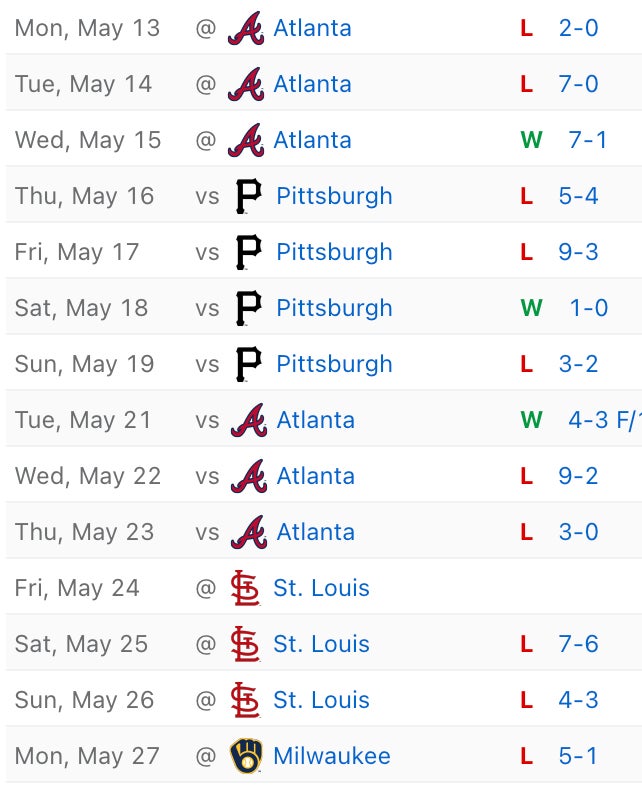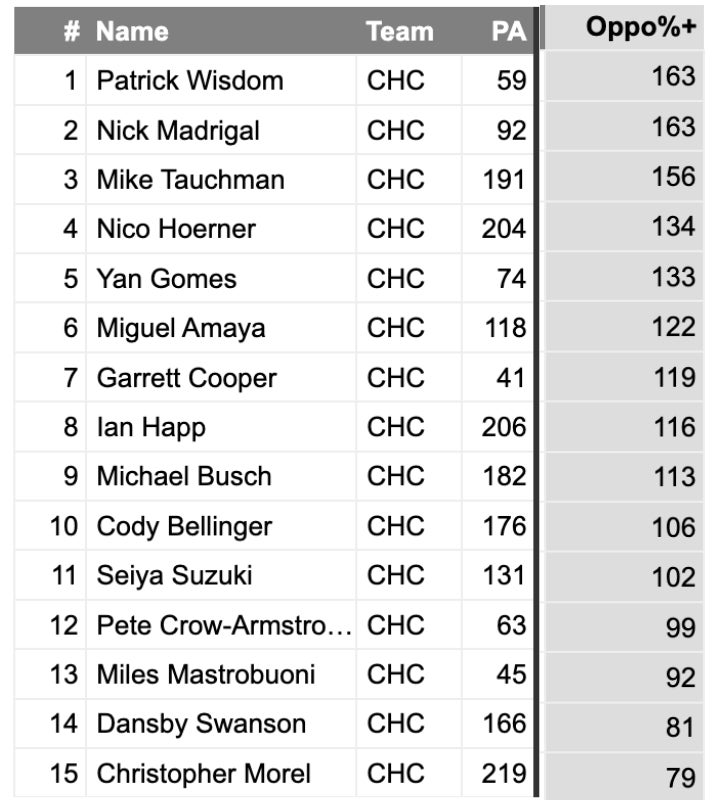A Complete Guide To Why The Chicago Cubs Suck (Right Now)

The Cubs are 3-10 over the last 2 weeks, 2-8 in the last 10, and currently enjoying an 0-5 stretch. It's been awful and that's because the lineup has been atrocious.
We'll get to that in a second, but first I want to build some context because the entire league is down this year. A man named Barry summarized it pertfectly for Sportico:
- The overall batting average for the 30 teams is .240. If it remains that way, it will be the lowest since the league batted .237 in 1968, the so-called year of the pitcher, when the leaguewide ERA was 2.98.
- Numbers ticked up a tad last season. The league batting average was .248, an increase from .243 in 2022.
- Fifteen of the 30 MLB teams are hitting below the league’s .240 average, including the Chicago White Sox at the bottom of the league at a miserable .214.
- Currently there’s $964.7 million worth of players on the injured list, most of that pitching.
The general ethos is that league offense has been reduced to the Bob Gibson-era despite a maximum amount of injuries to superstar veteran pitchers. Read more at your own leisure.
For now, it's important to reiterate that it's been a shitty year for most teams. Why and How is individually circumstantial, but nevertheless a good starting point. The Cubs' lineup, along with many other clubs, exists squarely in no-mans land of Major League Baseball.
Temporary or not, it's alarming because the Cubs rank in the 1st tier of budget, facility, fanbase, player-development resources and home-field advantage. For all the excuses in the professional game, it should never be this bad (in May):
- One player is over-performing relative to expectations: Patrick Wisdom has a 116 wRC+ in May
- Three other players have a wRC+ above 100: Nico Hoerner (136), Cody Bellinger (122), and Ian Happ (115). Productive, yes. But also anticipated to the extent that they're paid in line with their production. That might be our only fringe-positive.
- Seiya Suzuki and Dansby Swanson have been hurt, but also awful when healthy enough to play in May: 52 and 44 wRC+ respectively across 110 combined plate appearances.
- The catching sucks. In 84 combined PA’s, catchers have just 10 hits (8 singles) and 4 walks against 27 strikeouts.
- More specifically, Amaya and Gomes have netted -8.6 weight runs against average. No other catching tandem performed worse in May, or really even came close: the Cubs' catchers are roughly 50% worse than the next group in most aggregate-value-based statistics.
- 4 of 14 players performed above average vs. fastballs in May: Bellinger, Happ, Madrigal and Hoerner.
- 4 of 14 players performed above average vs. sliders in May: Wisdom, PCA, Nico Hoerner and Mike Tauchman
- 7 of 14 players posted negative WAR in May: Dansby, Mastrobouni, Morel, Suzuki, Madrigal, Miguel Amaya and Yan Gomes
Those are my numbers updated for Tuesday before the Brewers game. Maybe someone goes 1-4 tonight with a run scored to climb out of the negative WAR cellar. Or maybe we get run off the field once again. Regardless of tonight's outcome, the club looks lifeless and I suppose it's time we start blaming shit.
So let's do that. Let's talk about why we suck.
The Cubs are borderline ignorant to pull-side power. This is maybe the hardest thing to show you guys but the best starting point.
The approach is so heavily skewed towards the opposite field. That can be a good thing if everyone is healthy and clicking, but the margin between productivity and futility under this approach is much smaller. There's limited power (NL 10th of 15 in SLG), way too many strikeouts (NL 12th) and even worse average (14th). Opposing pitchers are eating the Cubs alive right now and it starts with their collective approach.
If you carry a shitty batting average, you need to hit for power. That's basic 101, entry level baseball. There needs to be a counter threat to the pitcher. It's not different than a pitcher with limited velocity needing to carry good command and offspeed. The less velocity, the more you need to be a complete pitcher.
The same margin of error applies to a lineup. If you can't hit for power, you need to hit for average. If you can't do either, you're completely fucked.
There's plenty of reinforcing measures. You can look at statistics and batted ball data. You can look at league comparisons and splits. You can watch for yourself or trust someone who does. End of the day, you'll come to the same conclusion that the lineup is severely missing thunder.
Personally I gravitate to the Oppo/Center/Pull neutralized-value stats at the player-level to read a broader team approach. A mouthful, yes. But an effective measure best explained with a picture:
100 is league average. Each point above or below represents a 1% deviation from MLB average.

That isn't awful, provided you have the slugging percentage to back it up. Anthony Rizzo went years before he started turning to right field without any sacrifice to power numbers. There's a way to do it effectively.
Problem is the 2024 Cubs aren't benefiting from that sacrifice. The majority of plate appearances focus on the opposite field where there's a clear drop-off in power

This leads to the most important distinction I can offer: there's too much going with the pitch vs. hammering the pitch you want.
In other words:
What's the use of working a count to your advantage if you're not an XBH threat?
Mistakes come when pitchers feel they can't make mistakes. The more of a threat, the smaller the window to execute, the more likely a pitcher will miss the window and more often you can hammer your pitch. It's all connected.
The Cubs don't really possess those threats in the lineup. They're built to stack baserunners with the goal of breaking down the opposing pitching staff over multiple games. They want high pitch counts, multiple relievers, balls-in-play and all the related metrics that swing the balance over a collective series. It may not work the first time through the lineup in the first game of a series, but the thinking suggests a significant advantage come the 12th time through the lineup in game 3. Keyword: suggests.
The reality has been much different, especially lately. We're watching bad grow worse without obstruction and it's nauseating.
But remember - MLB offense is at a 56-year low across the board. Most teams are underperforming as pitchers claim a bizarre shift in power. That's mostly attributed to player development and worth a lot more time to explain adequately. The takeaway for now is that most lineups are eating more shit than they expected.
Drilling down to the Cubs, that's due to a combination of injuries, approach and timing. Critique as you see fit: Seiya + Dansby have missed significant time. Michael Busch has come down to earth. Christopher Morel shows equal flashes on both ends of the spectrum. Madrigal plays too much/too poorly. Most backups have been forced into more regular playing time and the schedule has amounted to nothing short of extremely challenging.
There's so many considerations and they're all working towards the same truth: the Chicago Cubs have been categorically awful in May. So bad that we can't even complain about the bullpen because there haven't been any leads to blow. So keep that luxury in mind next time you want to execute a reliever: there's varying levels of pain and we've grown far away from the anguish of high leverage appearances.
At 1200 words, I'm now ready to claim the path forward. Someone (Ian Happ) needs to go on an absolute heater and bring a couple guys with him. We need his annual month of .450/.550/.650 and we need it right now. Then a couple younger guys start feeling good around the same time some older guys find a groove. We keep the starting pitching healthy and ride the warm weather into a burst of momentum. Somewhere along the way you'll get an 8-2 stretch and by then, Jed should have a grasp on the prospects/trade deadline relationship.
That's the way out of this bullshit and it's going to take the entire village starting tonight against the Brewers and rolling right into June.
Difficult, yes. But this roster is made exactly for that kind of stretch and it can start any game when you've got good starting pitching. So keep an open mind while backed into this corner. It can flip any moment and that should keep you moving. Otherwise just consider the following:
The Cubs are…
- 22-7 when scoring first
- 20-6 when scoring 4+ runs
- 14-6 in games started by a rookie pitcher
So let's keep it simple and just score some more runs.
Seems like that's our best strategy out of this hellhole.


